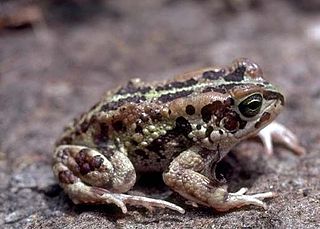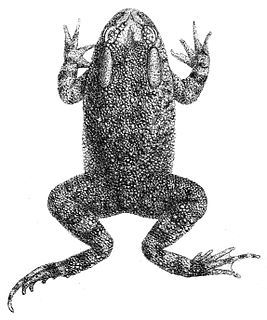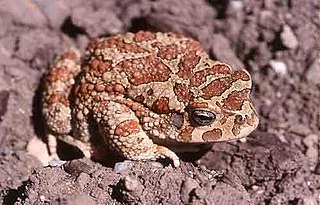Sclerophrys taiensis is a species of toad in the family Bufonidae. It is known from the Taï National Park in southwestern Ivory Coast and from the Gola Forest in southeastern Sierra Leone; it is likely that its range extends into the adjacent Liberia. Common name Tai toad has been proposed for it.
Sclerophrys asmarae, also known as the Asmara toad, is a species of toad in the family Bufonidae. It is named after its type locality, the capital city of Eritrea, Asmara. It is found on the Ethiopian Highlands on both sides of the Rift Valley, with the western population extending north into Eritrea. Its natural habitats are montane grasslands, and tentatively at lower elevations, arid savanna. It is a locally common and adaptable species that is impacted by habitat degradation, though probably without posing a serious risk.

Sclerophrys buchneri, also known as Buchner's toad, is a species of toad in the family Bufonidae. It is found in the Cabinda Province of Angola and western Republic of the Congo, presumably also in Democratic Republic of the Congo. The biology of this species is essentially unknown. It might even be synonym of Sclerophrys funereus.

Sclerophrys camerunensis is a species of toad in the family Bufonidae. It is found in southeastern Nigeria, southern Cameroon, Equatorial Guinea, Gabon, the Central African Republic, and the Democratic Republic of the Congo. The record from southwestern Tanzania is uncertain. It is presumed to occur in the Republic of the Congo. Records from West Africa probably refer to Sclerophrys togoensis. Common names Cameroon toad and Oban toad have been coined for this species.
Sclerophrys djohongensis is a species of toad in the family Bufonidae. It is endemic to the Adamawa Plateau in north-central Cameroon. It was originally described as a subspecies of Bufo funereus. It might even be a junior synonym of Sclerophrys villiersi.
Sclerophrys fuliginata is a species of toad in the family Bufonidae. The specific name fuliginata is Latin for "sooty", in reference to the species' appearance of a more or less diffusely uniform exterior color and pattern. It is also known as the Shaba Province toad or sooty toad. It is found in the southern Democratic Republic of the Congo, southeastern Tanzania, and northern Zambia.

Sclerophrys funerea is a species of toad in the family Bufonidae. It is found in west-central Africa, from Gabon, Republic of the Congo, and Angola eastward through the Democratic Republic of the Congo to Uganda, Rwanda, and Burundi. Its common names are Angola toad or somber toad.
Sclerophrys gracilipes is a species of toad in the family Bufonidae. It is found in southeastern Nigeria and east- and southward to southern Cameroon, Equatorial Guinea, Gabon, northern Republic of the Congo, and northern and northeastern Democratic Republic of the Congo. It is also likely to occur in southwestern Central African Republic and in the Cabinda Enclave of Angola. The holotype was collected from the Benito River in what was then French Congo. Common name French Congo toad has been coined for it.
Sclerophrys kerinyagae is a species of toad in the family Bufonidae. It is found in central Ethiopia, Kenya, northern Tanzania, and eastern Uganda. Common names Keith's toad and Kerinyaga toad have been coined for it.
Sclerophrys kisoloensis is a species of toad in the family Bufonidae. It is found in southwestern Kenya, Uganda, Rwanda, eastern Democratic Republic of the Congo, northeastern Zambia, western Tanzania, and northern Malawi. It probably also occurs in Burundi. Common names Kisolo toad and montane golden toad have been coined for it.
Sclerophrys langanoensis is a species of toad in the family Bufonidae. It is endemic to northern Rift Valley in Ethiopia, where it has been recorded from Lake Langano and the Awash National Park; the latter population might represent a distinct species. It is likely that this species will also be found in Eritrea and Somalia. Common name Lake Langano toad has been coined for it.

The Berber toad, also known as Mauritanian toad, Moroccan toad, pantherine toad or Moorish toad, is a species of toad in the family Bufonidae, which is found in north-western Africa, with an introduced population in southern Spain.

Sclerophrys perreti is a species of toad in the family Bufonidae. It is endemic to the Idanre Hills in southwestern Nigeria. Sclerophrys perreti is one of the frogs declared as "Lost" in 2010. However, it was re-discovered at its type locality in 2013. Before that, it had not been seen—possibly—since 1970, and with certainty, since 1963. Common name Perret's toad has been coined for it.

The raucous toad, also known as Ranger's toad, is a species of toad from Southern Africa.
Sclerophrys reesi, also known as Merara toad or Rees' toad, is a species of toad in the family Bufonidae. It is endemic to southern Tanzania and is only known from the Kihansi–Ulanga River floodplain from elevations of 200–500 m (660–1,640 ft) above sea level. It is named after Allen Rees, a principal game warden for the Tanzanian Wildlife Department who collected the type series.
Sclerophrys tihamica is a species of toad in the family Bufonidae. It is endemic to the Arabian Peninsula and occurs along the Red Sea coastline of Saudi Arabia and Yemen. It is sometimes known as Balletto's toad. Reports of Bufo pentoni from the Arabian Peninsula refer to this species.
Sclerophrys togoensis is a species of toad in the family Bufonidae. It is found in Ivory Coast, Ghana, Guinea, Liberia, Sierra Leone, and Togo. Its natural habitats are subtropical or tropical moist lowland forests and rivers. It is threatened by habitat loss.
Sclerophrys tuberosa is a species of toad in the family Bufonidae. It is found in southeastern Nigeria, Cameroon, southwestern Central African Republic, Equatorial Guinea, Gabon, and northern Democratic Republic of the Congo and Republic of the Congo. Common names rough toad, warty toad, and Fernando Po toad have been proposed for it.
Sclerophrys turkanae, the Lake Turkana toad or Turkana toad, is a species of toad in the family Bufonidae. It is endemic to Kenya, and is only known from two localities; Loiyangalani on the southeastern shores of Lake Turkana, and the Ewaso Ng'iro River in the Samburu National Reserve.
Phrynobatrachus villiersi is a species of frog in the family Phrynobatrachidae. It is found in southeastern Liberia, southern Côte d'Ivoire, and southwestern Ghana. Its natural habitat is tropical primary forest. The eggs are deposited on dried-up puddles just before the rains. It is very common in suitable habitat, but threatened by habitat loss caused by agriculture, logging, and human settlement.






